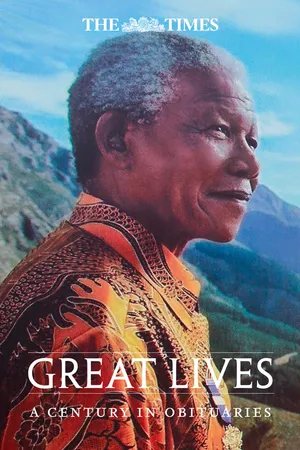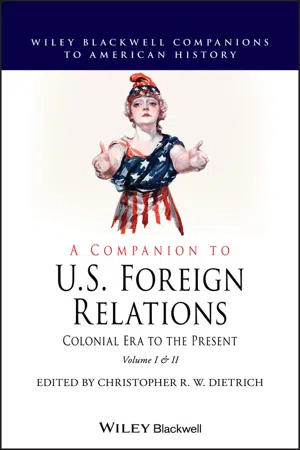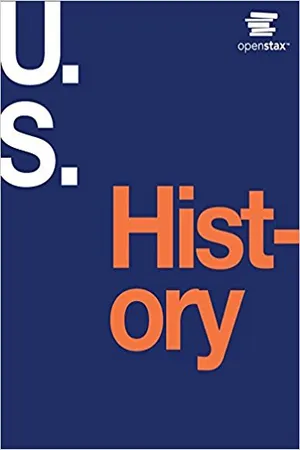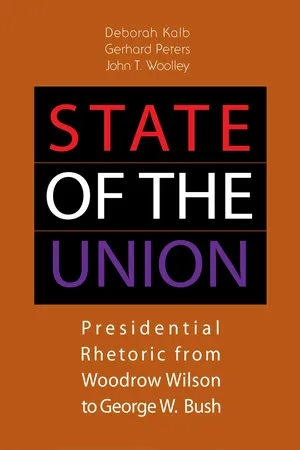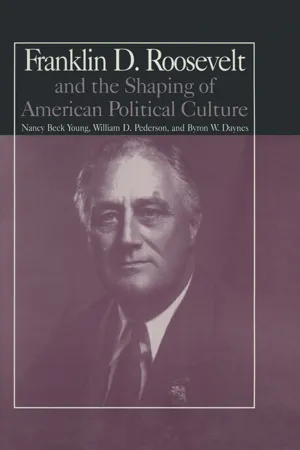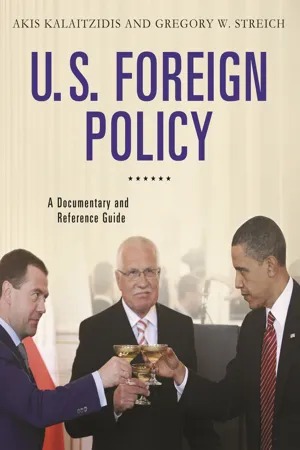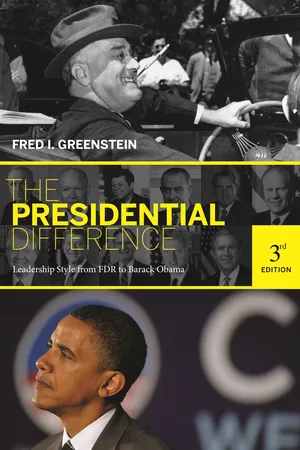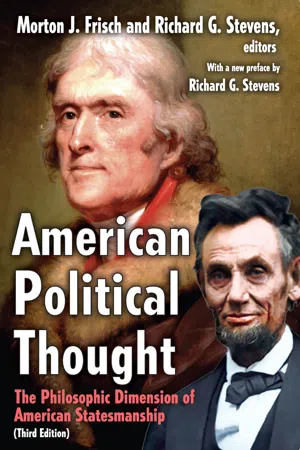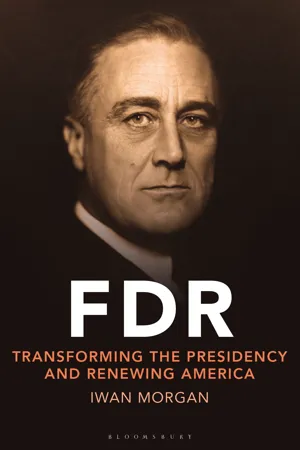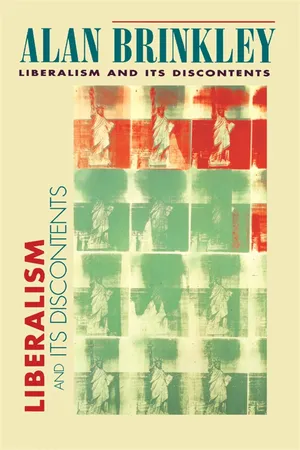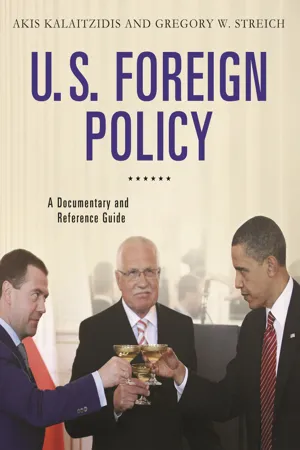History
Franklin D. Roosevelt
Franklin D. Roosevelt, often referred to as FDR, was the 32nd President of the United States, serving from 1933 to 1945. He is best known for his leadership during the Great Depression and World War II. FDR's New Deal programs aimed to provide relief, recovery, and reform, and his leadership helped shape the modern role of the federal government in the United States.
Written by Perlego with AI-assistance
Related key terms
1 of 5
12 Key excerpts on "Franklin D. Roosevelt"
- eBook - ePub
- (Author)
- 2015(Publication Date)
- Times Books(Publisher)
President Franklin D. Roosevelt
Four times chief executive of United States. Service in freedom’s cause. 12 April 1945The death of President Roosevelt from cerebral haemorrhage on Thursday afternoon at Warm Springs, Georgia, as announced in the later editions of The Times yesterday, robs the United States of its Chief Executive within less than six months of his election to serve a fourth term of office at the White House – a term without precedent in American history. Throughout yesterday the people of the United States, of the United Nations, and of all peace-loving States mourned the passing of a leader whose influence for good had extended far beyond his national boundaries.Franklin Delano Roosevelt, the thirty-first President of the United States, was, as his whole life attested, a man of destiny. From one fate to another he was called. Through two great and prolonged crises in his country’s history he set its course and steered it through. Each of them provided a searching test of character and statecraft, and each made its own demands upon the Chief Executive. In both of them, however, he retained the confidence and was upheld by the support of an immense majority of his fellow-countrymen. The place in history which he will fill in relation to the greatest of his predecessors has yet to be decided but one of the determining factors in regard to it will be that he alone of them was invested by his fellow-countrymen with a fourth term of office and at his elections secured more decisive votes than any Presidential candidate before him. It will be remembered also that his pre-eminence was by no means due to lack of opposition, for many of his policies were carried in the teeth of a resistance by powerful and vocal sections of the American public. He was in fact during his first three terms master of Congress for only one comparatively brief period, and after that was opposed as strongly by some important groups in his party as by the Republicans. He had often, therefore, to use outside opinion to force his own supporters to follow him. His ability to do so was one of the truest measures of his stature. His like can, indeed, only be sought among those whose idealism made a comparable appeal to his people, and whose actions were equally justified in the event. - eBook - ePub
A Companion to U.S. Foreign Relations
Colonial Era to the Present
- Christopher R. W. Dietrich(Author)
- 2020(Publication Date)
- Wiley-Blackwell(Publisher)
Chapter Eighteen Insulation : The Presidency of Franklin D. Roosevelt During the Years 1933–1941Kiran Klaus PatelThe presidency of Franklin D. Roosevelt (1933–1945) is often seen as a pivotal and transformative period in the history of American foreign relations. The United States played a crucial role in World War II and emerged from the conflict as one of the world's two superpowers, wielding global influence as never before. Roosevelt himself is often associated with a particularly internationalist brand of foreign policy, even if his approach was not canonized in a neologism, as in the case of his Democratic predecessor, Woodrow Wilson – there is no “Rooseveltism” to match “Wilsonianism.” Interestingly, the term most closely associated with FDR's presidency – the New Deal – is normally reserved for his pre‐war domestic policies. And while some of the defenders of the 32nd president praise his foreign policy and describe him as a capable and farsighted statesman, others have been much more critical, accusing him either of a lack of vision and a politics of procrastination or of leading the country into a needless war. To this day, Roosevelt's foreign policies remain highly controversial and evade easy categorization.This chapter examines the foreign relations of the Roosevelt presidency until 1941, when the United States joined World War II. It advances in three steps. In the first, it provides a succinct summary of the main historiographical trends and interpretations. The second summarizes my own arguments in this context, before the third points to new avenues of research. In sum, the chapter seeks to demonstrate that the pre‐1941 Roosevelt presidency deserves more attention that it has experienced to date. Research has to go further in overcoming old categories and dichotomies, such as isolationism versus internationalism, and in challenging established but too‐narrow differentiations between foreign affairs and domestic politics. Finally, the chapter argues for a more global approach to the history of U.S. foreign relations by bringing in transnational and comparative perspectives. - eBook - PDF
- P. Scott Corbett, Volker Janssen, John M. Lund, Todd Pfannestiel, Paul Vickery, Sylvie Waskiewicz(Authors)
- 2014(Publication Date)
- Openstax(Publisher)
In pursuit of these two goals, Americans re-elected Roosevelt for three additional terms in the White House and became full partners in the reshaping of their country. Chapter 26 | Franklin Roosevelt and the New Deal, 1932-1941 757 26.1 The Rise of Franklin Roosevelt By the end of this section, you should be able to: • Describe the events of the 1932 presidential election and identify the characteristics that made Franklin Roosevelt a desirable candidate • Explain why Congress amended the U.S. Constitution to reduce the period of time between presidential elections and inaugurations Franklin Roosevelt was part of the political establishment and the wealthy elite, but in the 1932 presidential campaign, he did not want to be perceived that way. Roosevelt felt that the country needed sweeping change, and he ran a campaign intended to convince the American people that he could deliver that change. It was not the specifics of his campaign promises that were different; in fact, he gave very few details and likely did not yet have a clear idea of how he would raise the country out of the Great Depression. But he campaigned tirelessly, talking to thousands of people, appearing at his party’s national convention, and striving to show the public that he was a different breed of politician. As Hoover grew more morose and physically unwell in the face of the campaign, Roosevelt thrived. He was elected in a landslide by a country ready for the change he had promised. THE ELECTION OF FRANKLIN ROOSEVELT By the 1932 presidential election, Hoover’s popularity was at an all-time low. Despite his efforts to address the hardships that many Americans faced, his ineffectual response to the Great Depression left Americans angry and ready for change. Franklin Roosevelt, though born to wealth and educated at the best schools, offered the change people sought. - eBook - PDF
State of the Union
Presidential Rhetoric from Woodrow Wilson to George W. Bush
- Deborah Kalb, Gerhard Peters, John T. Woolley(Authors)
- 2006(Publication Date)
- CQ Press(Publisher)
You, at this moment, have the honor to belong to a generation whose lips are touched by fire. You live in a land that now enjoys the blessings of peace. But let nothing human be wholly alien to you. The human race now passes through one of its great crises. New ideas, new issues—a new call for men to carry on the work of righteousness, of charity, of courage, of patience, and of loyalty . . . . However memory brings back this moment to your minds, let it be able to say to you: That was a great moment. It was the beginning of a new era . . . . This world in its crisis called for volunteers, for men of faith in life, of patience in service, of charity and of in-sight. I responded to the call however I could. I vol-unteered to give myself to my Master—the cause of humane and brave living. I stud-ied, I loved, I labored, unsparingly and hopefully, to be worthy of my generation.” Franklin D. Roosevelt, 1933–1937 Annual Message to Congress January 6, 1937 Franklin D. Roosevelt delivered his fourth State of the Union message two weeks before his second presidential inauguration. Roosevelt, a Democrat, had scored a huge landslide win in the presidential election of the previous November, triumph-ing over Republican Alfred M. Landon. Roosevelt took 60.8 percent of the vote and 523 of 531 electoral votes; Landon, the governor of Kansas, won only Maine and Vermont. Democrats padded their margins in Congress as well; in the new Congress, they would hold 75 of 96 Sen-ate seats and 333 of 435 House seats. The president’s first term had been historic. Working with Congress, Roosevelt had completely changed the role of the federal government. Dozens of new laws created dozens of new government entities, from Social Security to the Tennessee 270 ■ Franklin Delano Roosevelt Valley Authority. Along with the increase in federal government responsibilities, the power of the presidency had increased as well. - eBook - ePub
The M.E.Sharpe Library of Franklin D.Roosevelt Studies: v. 1
Franklin D.Roosevelt and the Shaping of American Political Culture
- Nancy Beck Young, William D. Pederson, Byron W. Daynes, NancyBeck Young(Authors)
- 2017(Publication Date)
- Routledge(Publisher)
6 Jacobs was as interested in seeing the third or fourth copy or reworking of a painting or bust as he was in securing the original artifact. This collection is therefore a fascinating resource for understanding how Americans commemorated FDR both before and after his death, and offers a way to supplement the more conventional use of print material for the interpretation of American political culture.For a rare few venerated presidents, powerful symbols have emerged to express popular and simplistic conceptions of their place in American history. These images help to both create a mythology of American leadership and maintain a collective memory of the presidency. Although these memories change over time, for these special presidents, their ranking at the top of the list of American presidents seems secure. According to one historian:Each of the three centuries since the founding of the American republic has produced a president whom the public reveres as an irreproachable paragon of leadership. The eighteenth century gave the nation George Washington, the … Father of his Country…. The nineteenth century witnessed the emergence of Abraham Lincoln … Great Emancipator. … The twentieth century has seen the elevation of Franklin Delano Roosevelt, Doctor New Deal and Doctor Win-the-War, his county’s leader in the best and worst of times.7Historians have consistently ranked Roosevelt as one of the greatest presidents of the United States along with George Washington and Abraham Lincoln. But this elevated ranking began in his own time, as seen in commercial items associating Roosevelt with a pantheon of exemplary presidents. A typical example is a cardboard fan held in the Center for New Deal Studies, which advertises Edinger’s Bakery in Philadelphia. Dated 1933, this object portrays a painting of FDR seated in front of a radio microphone on one side, surrounded by the approving visages of six previous “great” presidents, including Andrew Jackson, Abraham Lincoln, Theodore Roosevelt, Woodrow Wilson, Thomas Jefferson, and George Washington. On the back of the fan, the text suggests that this “president of all the people” has already (by 1933) been placed “on a par with great Presidents of the past. He stands today as a symbol of America, of the fighting, courageous, gallant America built by our leaders of the past.” There are also trays, dishware, and other items portraying FDR not only with past presidents, but with world leaders such as Winston Churchill.8 - eBook - PDF
U.S. Foreign Policy
A Documentary and Reference Guide
- Akis Kalaitzidis, Gregory W. Streich(Authors)
- 2011(Publication Date)
- Greenwood(Publisher)
Roosevelt 105 President Franklin D. Roosevelt delivers one of his popular fireside chats, a series of evening radio talks to the American public. Roosevelt used these chats to explain New Deal programs during the Great Depression and war policies during World War II. (Library of Congress) American independence, and all of the things that American independence means to you and to me and to ours. Tonight, in the presence of a world crisis, my mind goes back eight years to a night in the midst of a domestic crisis. It was a time when the wheels of American industry were grinding to a full stop, when the whole banking system of our country had ceased to function. I well remember that while I sat in my study in the White House, preparing to talk with the people of the United States, I had before my eyes the picture of all those Americans with whom I was talking. I saw the workmen in the mills, the mines, the factories, the girl behind the counter, the small shopkeeper, the farmer doing his spring plowing, the widows and the old men wondering about their life’s savings. I tried to convey to the great mass of American people what the banking crisis meant to them in their daily lives. Tonight, I want to do the same thing, with the same people, in this new crisis which faces America. We met the issue of 1933 with courage and realism. We face this new crisis, this new threat to the security of our nation, with the same courage and realism. Never before since Jamestown and Plymouth Rock has our American civilization been in such danger as now. For on September 27th, 1940—this year—by an agreement signed in Berlin, three powerful nations, two in Europe and one in Asia, joined them- selves together in the threat that if the United States of America interfered with or blocked the expansion program of these three nations—a program aimed at world control—they would unite in ultimate action against the United States. - eBook - ePub
The Presidential Difference
Leadership Style from FDR to Barack Obama - Third Edition
- Fred I. Greenstein(Author)
- 2012(Publication Date)
- Princeton University Press(Publisher)
In the depths of the Great Depression, Franklin Roosevelt restored faith in a political system that Americans had few reasons to respect. Following Pearl Harbor, he rallied the nation and its allies in an epic conflict in which victory was by no means assured. Both as an inspirational leader and as a master politician, FDR provides a benchmark for later presidents.(Corbis/Bettmann -UPI)CHAPTER 2
The Virtuosic Leadership of Franklin D. Roosevelt
This great Nation will endure as it has endured, will revive and will prosper. So, first of all, let me assert my firm belief that the only thing we have to fear is fear itself – nameless, unreasoning, unjustified terror which paralyzes needed efforts to convert retreat into advance. In every dark hour of our national life a leadership of frankness and vigor has met with that understanding and support of the people themselves which is essential to victory. I am convinced that you will again give support to leadership in these critical days.– FRANKLIN D. ROOSEVELT ,FIRST INAUGURAL ADDRESS ,MARCH 4, 1933Very often when some matter was being fought out with his advisers, he would bring up the question at dinner and bait me into giving an opinion by stating as his own a point of view with which he knew I would disagree. He would give me all the arguments which had been advanced to him, and I would try vociferously and with heat to refute them. I remember one occasion … when I became extremely vehement and irritated. My husband smiled indulgently and repeated all the things that everyone else had said to him. The next day he asked Miss Thompson if she could have tea in the West Hall in the White House for him and Robert Bingham, who was then our Ambassador to London and about to return to his post.I dutifully served them with tea, fully expecting to sit and listen in silence to a discussion of questions with which I probably would not be in agreement. Instead, to my complete surprise, I heard Franklin telling Ambassador Bingham to act, not according to the arguments that he had given me, but according to the arguments that I had given him! Without giving me the satisfaction of batting an eyelash in my direction, he calmly stated as his own the policies and beliefs he had argued against the night before! To this day I have no idea whether he had simply used me as a sounding board, as he so often did, with the idea of getting the reaction of the person on the outside, or whether my arguments had been needed to fortify his decision and to clarify his own mind. - eBook - ePub
American Political Thought
The Philosophic Dimension of American Statesmanship
- Morton Grodzins, Richard Stevens(Authors)
- 2017(Publication Date)
- Routledge(Publisher)
Franklin Delano Roosevelt Morton J. Frisch I There is no doubt that Franklin D. Roosevelt, considered as a thinker and a statesman, rates lower than Abraham Lincoln. While one must admit that he proceeded with practical wisdom and moderation, one cannot compare him to Lincoln m depth of understanding. The successful handling of the situation of the Great Depression, that is, the preservation of liberal democratic institutions in a period of crisis, was one which involved an unusual degree of practical wisdom and moderation. Those qualities Roosevelt had, but that is not to say that he possessed theoretical wisdom. Roosevelt was emphatically a politician, a master politician. That the American people were able to withstand the shock of an unparalleled depression and that their concern for their well-being did not deteriorate into despair was, in large measure, due to the sobriety and restrained character of his statesmanship. And that sobriety and restraint were as much a part of the action of the New Deal as were the major pieces of New Deal legislation. Roosevelt’s New Deal has been described by some as “the prologue to Communism in America” 1 and, in order to substantiate that view, his critics have emphasized that he was fomenting class war by talking about the great industrial and financial interests as moneychangers and economic royalists. As a matter of fact, Roosevelt leveled the charge of “money-changers” against big industry and finance in his First Inaugural Address, and complained about ‘economic royalists” in his second presidential campaign, giving the impression of a conspiracy on their part. His rhetoric clearly exaggerated the existing state of the danger, at least from them, but his intention was to expose the threat to capitalism by exaggerating it. It seems to be clear that Roosevelt recognized and generally exercised moderation - eBook - ePub
FDR
Transforming the Presidency and Renewing America
- Iwan Morgan(Author)
- 2022(Publication Date)
- Bloomsbury Academic(Publisher)
1 FDR’s pre-presidencyThe making of a leaderFranklin Delano Roosevelt was born on 30 January 1882 at Springwood, near Hyde Park, New York, into an old, moneyed and well-connected family. His privileged background helped him rise to the presidency, but other factors were just as important. He developed a driving ambition more typical of self-made men in pursuit of political rather than financial advancement. A quick study, he learned the art of politics and the craft of government during tenures in state and federal offices. An attack of polio that left him without the use of his legs at age thirty-nine seemingly threatened his inexorable rise, but the determination not to be limited by disability only intensified his presidential aspirations. These diverse elements in FDR’s character and experience made him the president he became.Roosevelt’s parents belonged to the social elite that was America’s closest equivalent to an aristocracy, its pedigree defined by ancestral settlement in colonial times, long-established wealth and commitment to public service. By the 1880s business tycoons were leading America’s march to modern economic might, making themselves ostentatiously super-rich in the process. Despite being surpassed in wealth, the thoroughbred heritage of families like the Roosevelts kept them atop the social order. These self-designated ‘best people’ considered themselves necessary counterweights to the materialism of the new-money class in undertaking public service and charitable activities that cemented societal solidarity in times of great change.1The American origins of FDR’s father, James, went back seven generations to a Calvinist Dutch family – whose name meant ‘rose field’ – come to New Amsterdam in the 1640s. FDR’s mother, Sara, traced her Delano lineage back to Calvinist Huguenot and English Puritan Pilgrims who settled the Plymouth Colony in the early 1620s. ‘May you always bear in mind’, James counselled his teenage son, ‘that in the past – on both sides of your ancestry – they have a good record and have borne a good name.’2 - eBook - PDF
- Alan Brinkley(Author)
- 2000(Publication Date)
- Harvard University Press(Publisher)
1 The Rise of Franklin Roosevelt In 1945, shortly after Franklin Roosevelt died, Woodie Guthrie wrote a song he called “Dear Mrs. Roosevelt”—a song intended to serve as both a condolence and a tribute. In it Guthrie described several important events and accomplishments of Roosevelt’s life (not all of them accu-rately) and punctuated his account with the refrain “The world was lucky that he walked.” Through much of his life, of course, Franklin Roosevelt could not walk, as Guthrie probably knew. But to Guthrie, as to many other Americans of his generation, he seemed for a time to bestride the earth; and the literal truth of his life seemed less important than the powerful image he had—half purposefully, half inadvertently—created in the popular imagination. 1 Even a half-century later, Roosevelt’s reputation seems unusually malleable. Public ªgures across the ideological spec-trum try to seize a piece of his legacy—at times to justify their efforts to dismantle it—without much concern about who Roosevelt himself ac-tually was or what he actually did. In the popular mind, Roosevelt the icon has transcended Roosevelt the president, Roosevelt the politician, Roosevelt the New Dealer, and Roosevelt the man. He has become a ªgure of myth: a man for all seasons, all parties, and all ideologies. But Roosevelt the man was not an icon. He was, rather, a compli-cated, elusive, at times even devious ªgure. He was both a friend of the common people, as Woody Guthrie believed, and a creature of the American aristocracy. He was both a great statesman and a consummate defender of his own political self interest. He was generous as well as 1 vindictive. He was capable of broad vision and petty deceit. He had millions of friends and no intimates. Even those who felt closest to him knew only a small part of his carefully concealed inner self. - eBook - PDF
- Stephen Hess, James P. Pfiffner(Authors)
- 2002(Publication Date)
- Brookings Institution Press(Publisher)
CHAPTER Franklin D. Roosevelt I 933~ I 945 When Franklin Delano Roosevelt assumed the presidency in March 1933, the White House staff consisted of thirty-seven people, nine of profes-sional rank. Those in the three key positions, known as secretaries to the president, were assigned to handle appointments, press, and correspon-dence. The executive branch also included a career executive clerk in charge of presidential mail and files; the Bureau of the Budget, located in the Treasury Department but otherwise an arm of the presidency, employing thirty-five persons; and ten cabinet departments. 1 A number of commis-sions, although within the executive establishment, were beyond the range of presidential control, except for the power to appoint members for fixed terms. In all there were 578,231 executive branch employees, of whom 467,161 were in the classified civil service. A considerable proportion of them, in the opinion of a Roosevelt adviser, had been appointed during the preced-ing twelve years of Republican rule. . . . What we called the Civil Service was, in the main, merely a mass of Republican political appointees frozen into office by act of Congress. 2 It was a familiar arrangement, and other administrations had found it workable. But the election year just past had seen the Great Depression spread inexorably. The agricultural heartland was devastated by years of drought and mismanagement of the land. Banks were failing at a rate of a 21 3 22 Franklin D. Roosevelt hundred a month. More than a quarter-million families had been evicted from their homes. The government Roosevelt inherited had neither the structure nor the personnel to deal with the most serious economic crisis in the nations history. The new president would change that forever, not simply by enlarging the government but by fundamentally redefining its goals and the way it achieved them. He would, in effect, be the first person to be the presiding officer of the modern presidency. - eBook - ePub
U.S. Foreign Policy
A Documentary and Reference Guide
- Akis Kalaitzidis, Gregory W. Streich(Authors)
- 2011(Publication Date)
- Greenwood(Publisher)
President Roosevelt was an astute politician, and he used his powers to evade the Neutrality Acts in order to gently mobilize his country toward eventual entry into the war, in 1941. He used his persuasive powers in a series of “fireside chats” broadcast by radio to argue that the United States, even though neutral, could not avoid seeing the moral imperatives in the war being waged in Europe. He called for America to be the “arsenal of democracy” against fascism and, even though bound by law, he found ways to help Britain in its battle against Germany. He gave Britain destroyers from the U.S. Navy in exchange for military bases, he expanded the U.S. Navy’s control of the western Atlantic all the way to Iceland, and he invented a further way of helping the financially devastated British government through a “lend/ lease” program. He argued that the executive branch should be uninhibited in its duties as the primary foreign policymaker in the United States and used his powers to punish Japanese aggression in China by imposing trade sanctions on Japan. This last move, however, backfired when the military-dominated government of Japan responded not by pursuing a negotiated settlement with the United States but by initiating a war with the United States when it attacked the U.S. naval base in Pearl Harbor, Hawaii, on December 7, 1941, an attack that killed thousands of U.S. sailors and destroyed several ships. American neutrality was no more, and within days, the United States entered World War II on two fronts.During FDR’s presidency, the United States improved its domestic economy by establishing new regulatory agencies and laws governing the workplace, emerged victorious from World War II, firmly established itself in Latin America, and, finally, acquired new interests in the Middle East, Southeast Asia, and elsewhere around the globe. FDR’s foreign policy achievements cannot be overstated; he was not only an effective manager of the war and its contingencies but a great leader with the foresight to set a long-term agenda for the United States. He also helped create the United Nations, carrying forward the Wilsonian notion that an international body could potentially prevent future conflicts from blossoming into full-scale wars. At the end of World War II, the future for the United States was bright: It emerged as a global superpower, taking over from the British, who had to adjust to their new status as a second-class global power. World War II saw the beginning of the dismantling of the British and French empires and the emergence of the United States as a preeminent economic, military, and political power on the world stage.On the other hand, FDR’s policies in regions such as Latin America and the Middle East sowed the seeds of future wars and conflicts that would challenge future U.S. presidents. FDR’s negotiations with Middle Eastern powers such as Iran and Saudi Arabia were the cornerstone of a Middle East policy that remains problematic, and his involvement in Southeast Asia would lead to U.S. involvement in a war in Vietnam that could not be won. His commitments to wartime allies would create a great deal of resentment after the war was over, in the Soviet Union and China, for example, and would plunge the United States into a “Cold War” that would completely transform the United States and the world once again.
Index pages curate the most relevant extracts from our library of academic textbooks. They’ve been created using an in-house natural language model (NLM), each adding context and meaning to key research topics.
